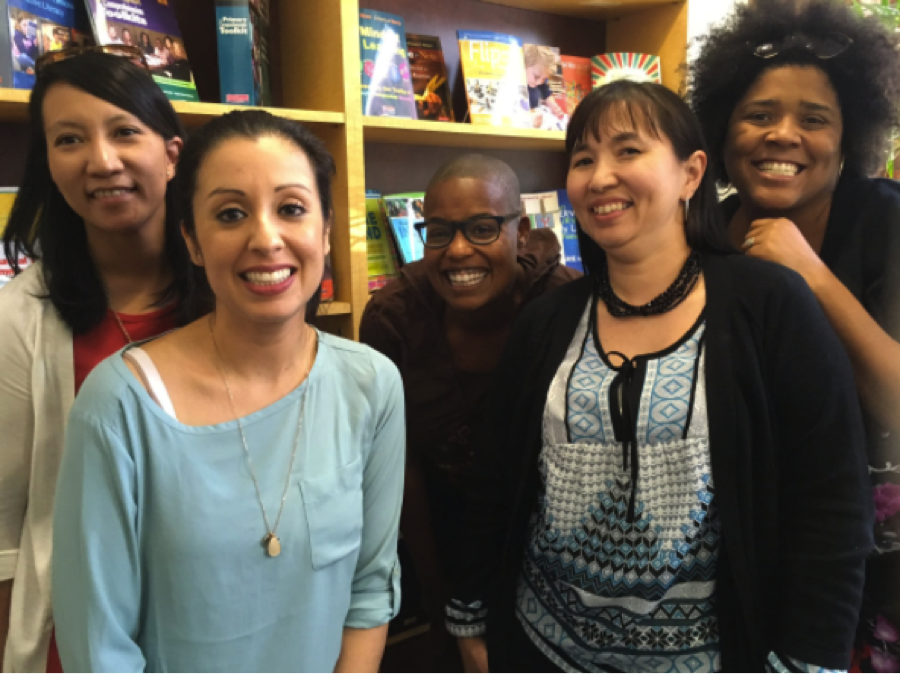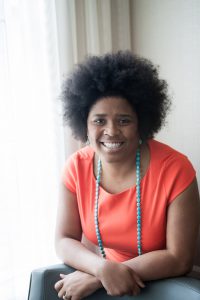
As a college student, at twenty, I found myself under the tutelage of an educator of color for the first time ever. I did not learn from another one until I was thirty. During my tenure as an educator, I have served students as diverse as America itself. I scoured my memory. I can merely recall fewer than ten colleagues of color among the hundreds with whom I’ve worked. In March I traveled from rural Alaska to New York City to visit Heinemann Fellow Tiana Silvas and her colleagues at PS 59. I was looking for effective instructional strategies. At forty, nineteen years into my teaching career, I found what I hope all thoughtful, passionate educators, regardless of race or ethnicity, will someday find in order to better serve our students. I found community—just as I am.
♦ ♦ ♦
To Tiana, With Love
I teach you truths. My truths. Yeah, it is kinda scary, dealing with the truth. Scary, and dangerous. —Mark Thackeray in To Sir, with Love
♦ ♦ ♦
Dearest Tiana,
It’s been a few weeks since I visited your classroom and we shared dinner with friends, the one where I probably said too much. I do that a lot—open my mouth and let the unstoppable truth flow out like the waters of the Zambezi at Victoria Falls—but it seems to happen every time I’m engaged in conversation with you. It’s like you’re some sort of truth serum or something.
Speaking the truth isn’t always the easiest thing to do, especially in our profession . . . and in our skin. Elementary school teachers are supposed to be sugar, spice, and everything nice cloaked in apple jumpers, not thinking people who dare to speak hard truths. And as teachers of color we are admonished to wrap those truths up in Rev. Dr. Martin Luther King Jr.’s most innocuous quotes, the ones cited so frequently they’ve become platitudes. We have to tell the truth the way others want to hear it in order to be heard. It’s tough following all those rules, isn’t it? Self-restraint feels so much like failure when we, the teachers of color who represent only 13 percent of all teachers, so desperately want to be heard it seems like only shouting will do.
When I entered my first classroom nearly nineteen years ago, I was aware of the history of the American school system. I understood it both intellectually and personally. My own mother attended segregated schools. But in my naïveté, I had not yet been compelled to consider how our stories—theirs, yours, mine, and ours—might weave a web I would spend my entire career untangling. I was a person of color and knew the significance of being a teacher of people of color, but I did not identify as a teacher of color. I was not quite “woke.”
Whether we shout or whisper, we are a collection of our stories. Our stories are our truth. And, Tiana, the truth is, as Chimamanda Ngozi Adichie told us, “Stories matter. Many stories matter.” Pondering our stories awakens us. In the weeks since I spent time in your classroom, I’ve been consumed with the idea that our stories are perhaps the most powerful tools we have to make authentic connections with our students, our colleagues, ourselves, and, together, to engage with the larger world. We often talk about how books do this, how we should make our reading lives available to our students and one another. But what about our own stories, our life lives?
You’ve begun to share some of your stories with me, but I know we’ve barely skimmed the surface. I saw it in the way your eyes smiled at a student who was struggling with your expectations. I heard it in the tenderness of your voice when you called him “baby” as you redirected him—again. I felt it in the passion of your gesticulations when you told your colleague you’d done enough test prep for the day because you had a conviction, a higher calling: “If I don’t teach them the Declaration of Independence, I’m not doing my job!” It permeated your classroom, the safe space where many of your students chose to spend their lunch break honing their essays.
It. It is your view of the child as the center of the work we do. It is your belief that education is a journey to personal and universal truths. It is your understanding that love is the force that has the greatest potential to empower our teaching and that is why our interactions with students must always be relational, not transactional. It is you allowing your life life, your stories, your truths to be the raw material from which your teaching persona is molded. Your philosophy is perhaps a product of your education, but your compassionate teaching style was borne of your experiences.
It was there in your classroom, as we pondered difficult questions and hard truths, that I confirmed though many of our experiences are different, the ones that inform our teaching are, indeed, quite similar. It was like Barbara Pegg says at the moment she sees her teacher Mark Thackeray in To Sir, with Love, “Well, Sir, you’re like us, but you ain’t . . .”
Your stories, you, are not just a window—a case study of the cosmopolitan teacher for my rural, rugged self—but a mirror as well. Watching you teach was like peering at my reflection for the first time and realizing that perhaps I am not, as I’ve been told, a teacher who’s wandered “too far out of the box,” but rather a swan of sorts. I was in awe, speechless. It’s always been easy for me to be moved by the beauty just outside almost any window, but finding it in my own reflection filled a space in my teacher heart I was not aware was empty. Oh, my friend, our stories were carving out a niche for us while we were busy living them.
Tiana, our time together awakened me to my need, as a teacher of color, to fellowship with other teachers of color. It gave me permission to embrace the vulnerability that comes with being every bit of myself. It gave me permission to pose difficult questions and search for the potentially frightening answers, the truth. It gave me permission to be “woke.”
I applied for the Heinemann Fellowship for so many reasons. I wanted to be part of a community that values teaching as a profession of compassionate intellectuals, people like you. I wanted a place to splay my current thinking and outgrow myself. I wanted a platform from which I could share my story and my Native Alaskan students’ stories, and be heard without having to shout. I wanted to write. Still, I included the Socratic paradox in my application: I know that I know nothing. Getting to know you has reaffirmed that I am, indeed, ignorant.
Being a teacher of color matters for us—both individually and collectively—and for every one of our students who need mirrors and, yes, windows. I’m still waking up. I’m still learning. And you, Tiana, have become my newest teacher.
Thank you.
With love,
Aeriale (above, far right) with Heinemann Fellows (l–r) Tricia Ebarvia, Tiana Silvas, Kim Parker, Anna Osborn)
 Aeriale has been teaching in Alaska since 2005 and has served at nearly every level of public education. “Professional educators need to question the world around them, but especially themselves. We cannot reflect on our practice without inner reflection. As an educator, I consider it a moral and ethical imperative.” She teaches 2nd Grade at Joseph & Olinga Gregory Elementary School.
Aeriale has been teaching in Alaska since 2005 and has served at nearly every level of public education. “Professional educators need to question the world around them, but especially themselves. We cannot reflect on our practice without inner reflection. As an educator, I consider it a moral and ethical imperative.” She teaches 2nd Grade at Joseph & Olinga Gregory Elementary School.


